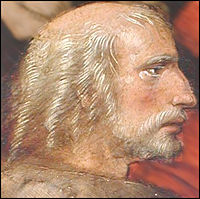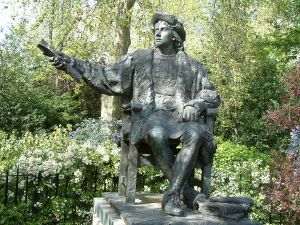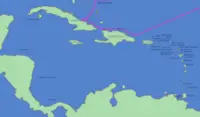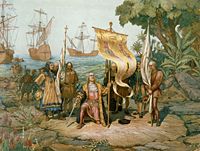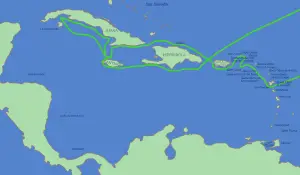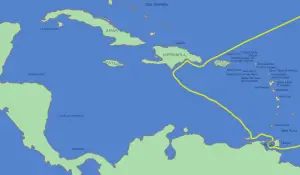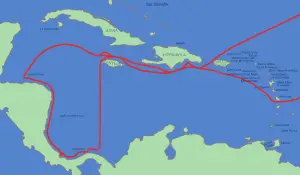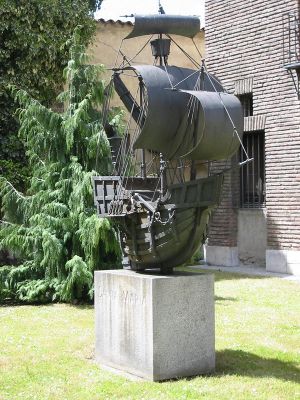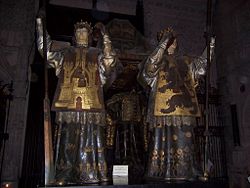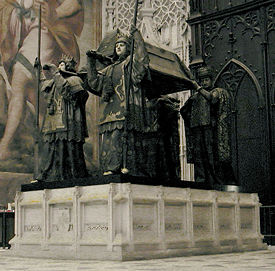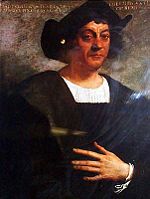Encyclopedia, Difference between revisions of "Christopher Columbus" - New World
(approved) |
m ({{Paid}}) |
||
| Line 1: | Line 1: | ||
| − | {{Approved}}{{Images OK}}{{Contracted}}{{Submitted}} | + | {{Paid}}{{Approved}}{{Images OK}}{{Contracted}}{{Submitted}} |
| − | {epname}} | + | {{epname}} |
{|align="left" | {|align="left" | ||
|[[Image:Face Christopher Columbus.jpg|thumb|200px|Christopher Columbus is depicted here in his only state-sponsored, albeit non-authenticated, portrait, painted by Alejo Fernández between 1505 and 1536. Photo by Manuel Rosa]] | |[[Image:Face Christopher Columbus.jpg|thumb|200px|Christopher Columbus is depicted here in his only state-sponsored, albeit non-authenticated, portrait, painted by Alejo Fernández between 1505 and 1536. Photo by Manuel Rosa]] | ||
Revision as of 19:48, 26 September 2006
Christopher Columbus (circa. 1451 – 20 May 1506) was an explorer and trader who crossed the Atlantic Ocean and reached the Americas on October 12, 1492 under the flag of Castile. Western history places great significance on his landing in America in 1492, with the entire period of the history of the Americas before this date usually known as Pre-Columbian. The anniversary of this event, Columbus Day, is celebrated in many parts of America. Although there is evidence of Pre-Columbian trans-oceanic contact, Columbus is commonly credited as the first European to see the Americas because of the profound impact his contact wrought on history. Columbus is said to have been born in Genoa, in modern Italy, according to statements attributed to Columbus himself, members of his family, and others who knew him well. However, some historians claim he could have been born in other places, from the Aragón to the Kingdoms of Galicia or Portugal, or in the Greek island of Chios, among others.
His voyage marked the beginning of European exploration and colonization of the Americas. The legacy of his voyages is regarded by some as largely negative, resulting in the exploitation of the Americas, the near-genocide of many of its peoples and the destruction of ancient cultures. For good or for ill, the world was changed and the impact of his life lives on. Columbus was a religious man, too, and believed that by finding what he believed was a sea-route to the East, he might connect Europe with the legendary kingdom of Prester John, who would aid Europe in the struggle against Islam. Towards the end of his life he favored another crusade to retake Jerusalem. Significantly, the year that he sailed West (1492) saw the fall of Grenada, the last Muslim city in Spain but 1453 had seen the loss of Constantinople to the Christian world. Many Christians, including Columbus, wanted to re-capture Constantionople. Columbus set out to find a sea-route to the East but ended-up in the West. The 1892 celebration of Columbus' journeys also saw the first international gathering of representatives of the world's majopr religions, as an attempt to establish shared values.
Columbus' theories
Christian Europe, which had long enjoyed safe passage to India and China—sources of valued goods such as silk and spices—under the hegemony of the Mongol Empire (the Pax Mongolica, or "Mongol peace"), was by the 15th century, after the fragmentation of the Mongol Empire, under complete economic blockade by Muslim states. In response to Muslim domination on land, Portugal sought an eastward sea route to the Indies, and promoted the establishment of trading posts and later colonies along the African coast. Columbus had a different idea. By the 1480s, he had developed a plan to travel to the Indies (then construed roughly as all of south and east Asia) by instead sailing directly west across the "Ocean Sea" (the Atlantic).
It is sometimes claimed that the reason Columbus had difficulty obtaining support for his plan was that Europeans believed that the earth was flat.
Eratosthenes (276-194 B.C.E.) had already, in ancient Alexandrian times, accurately calculated the Earth's circumference. Most scholars accepted Ptolemy's claim that the terrestrial landmass (for Europeans of the time, comprising Eurasia and Africa) occupied 180 degrees of the terrestrial sphere, leaving 180 degrees of water.
Columbus, however, accepted the calculations of Marinus of Tyre that the landmass occupied 225°, leaving only 135° of water. Moreover, Columbus believed that 1° represented a shorter distance on the earth's surface than was commonly held. Finally, he read maps as if the distances were calculated in Italian miles (1238 meters or 4060 feet). Accepting the length of a degree to be 56 2/3 miles, from the writings of Alfraganus, he therefore calculated the circumference of the Earth as 25,255 km (15,700 modern statute miles) at most, and the distance from the Canary Islands to Japan as 3000 Italian miles (some 3700 km). Columbus did not realize that Alfraganus used the much longer Arabic mile of about 1830 meters. He was not alone in "wishing" the earth smaller, however. A stunning image of the virtual Earth inside his mind survives to this day in a globe finished in 1492 by Martin Behaim of Nuremberg, Germany, "the Earthapple."
The problem facing Columbus was that most experts did not agree with his estimate of the distance to the Indies. The true circumference of the Earth is some 40,000 km (24,900 statute miles of 5280 feet each), and the distance from the Canary Islands to Japan is some 10,600 nautical miles (19,600 km). No ship in the 15th century could carry enough food or sail fast enough from the Canary Islands to Japan.
Those experts were right, of course, but Spain, tenuously unified through the marriage of Ferdinand and Isabella, then suddenly unified in faith after an eight-century struggle with the Muslims — followed by the expulsion of the Jews that same eventful year of 1492 — was in a messianic fever and desperate for a competitive edge over Portugal. The Portuguese had managed to circumnavigate Africa and were poised to establish trade with "the East Indies" (all of Asia). The Canaries, the Azores and the Madeira island groups had all been discovered within the past century. If nothing else, Columbus's scheme might turn up more islands, and in the unlikely event he was right about reaching "Farther India" in the western sea — and actually returned — it would have been a gamble worth taking.
Columbus was incorrect about the circumference of the Earth and the distance from the Canary Islands to Japan, but Europeans were mistaken in assuming that the aquatic expanse between Europe and Asia was uninterrupted by anything more than the mythical islands of medieval tradition. Columbus died believing he had opened up a direct nautical route to Asia. However, in his last year, Amerigo Vespucci (1454-1512) lived in his household and had confirmed from his own voyages that Columbus had found another continent (today's South America). But Columbus (and many mapmakers) pictured it "dangling" from Asia. It would take four more centuries to fully map the planet, leaving the legacy of Columbus's trans-oceanic leap impossible to quantify. The other half of the Earth can only be found once, and it was as confusing to him and the rest of the Old World as it was to the American civilizations.
Columbus's campaign for funding
Columbus first presented his plan to the court of Portugal in 1485. The king's experts believed that the route would be longer than Columbus thought (the actual distance is even longer than the Portuguese believed), and they denied Columbus' request. It is probable that he made the same outrageous demands for himself in Portugal that he later made in Spain, where he went next. He tried to get backing from the monarchs Ferdinand II of Aragon and Isabella I of Castile, who, by marrying, had united the largest kingdoms of Spain and were ruling them together.
After seven years of lobbying at the Spanish court, where he was kept on a salary to prevent him from taking his ideas elsewhere, he was finally successful in 1492. Ferdinand and Isabella had just conquered Granada, the last Muslim stronghold on the Iberian peninsula, and they received Columbus in Córdoba, in the monarchs' Alcázar or castle. Isabel finally turned Columbus down on the advice of her confessor, and he was leaving town in despair, when Fernando intervened. Isabel then sent a royal guard to fetch him and Fernando later rightfully claimed credit for being "the principal cause why those islands were discovered". King Fernando is referred to as "losing his patience" in this issue, but this cannot be proven.
About half of the financing was to come from private Italian investors, whom Columbus had already lined up. Financially broken from the Granada campaign, the monarchs left it to the royal treasurer to shift funds among various royal accounts on behalf of the enterprise. Columbus was to be made "Admiral of the Seas" and he would receive a portion of all profits. The terms were absurd, but as his own son later wrote, the monarchs did not really expect him to return.
Portugal and its Controversy
There is also the theory that Columbus was a Portuguese double agent helping to force Spain into a new treaty. Spain had never been an exploring nation prior to 1492 and never had its eyes set on India but Portugal had sought this sea route secretly for 60 years. Portugal feared that once it opened the seaway to India, Spain would be right behind them. This was the case with all of the Western Africa discoveries made by Portugal from 1434 until 1484 (Ivory Coast, Gold Coast, Slave Trade, etc.) places where Spain continuously sailed to raid and trade without rights to do so. Portugal and Columbus, theoretically, knew about the Americas before the rest of Europe did because of the secret voyages done by its Templar Order of Christ headed by Henry the Navigator). Columbus's job would have been to sail to the Americas and convince Spain that it was the famous India thus giving Isabel a reason to want to sign a new treaty with Portugal. Isabel believed the Treaty of Tordesillas prohibited Portugal from entering into India. However, Spain was foiled by Columbus and the real India was thus saved for Portugal.
Columbus was the only expert Spain had to rely on as far as information of the New World and Columbus's lies only benefited Portugal. Not only was Portugal in a better position to negotiate because of their secret knowledge of the Atlantic Ocean but the treaty would never have been done if it wasn't for the king of Portugal. King John II not only crafted this treaty he was the only one who requested it. Had John II simply played dead after the first voyage there would be no Treaty of Tordesillas.[1] Portugal knew well what it was doing. Portugal and its agent Columbus both knew that he had never sailed in the direction of India. Portugal and Columbus both knew that Portuguese ships captained by Bartolomeu Dias had already visited the Indian Ocean in 1487. Furthermore a Poruguese spy Pêro da Covilhã had already been to India sailing on Arab ships and done a secret map of that sea route. Columbus stopped in Lisbon March 4, 1493 and met with the King of Portugal thus giving him all the information on those new lands before Queen Isabel and King Fernando even knew that he had returned safely to the Old World.
Queen Isabella and King Ferdinand
According to the extraordinary contract that Columbus made with King Ferdinand II of Aragon and Queen Isabella of Castile, if Columbus discovered any new islands or mainland, he would:
- 1. be given the rank of Admiral of the Ocean Sea (Atlantic Ocean).
- 2. be appointed Viceroy and Governor of all the new lands.
- 3. have the right to nominate three persons, from whom the sovereigns would choose one, for any office in the new lands.
- 4. be entitled to 10 percent of all the revenues from the new lands in perpetuity; this part was denied to him in the contract, although it was one of his demands.
- 5. have the option of buying one-eighth interest in any commercial venture with the new lands and receive one-eighth of the profits.
It is important to note that many of the smears against Columbus were initiated by the Spanish crown when this contract was broken, and during the subsequent lengthy court cases (pleitos de Colón). This contract was unenforceable because Cristoval Colon was an assumed identity, an alias, and the kings as well as Colon were aware that he could never win this fight in a court of law without having to disclose his real identity.[2]
Voyages
- Your Highnesses, as Catholic Christians, and princes who love and promote the holy Christian faith, and are enemies of the doctrine of Mahomet, and of all idolatry and heresy, determined to send me, Christopher Columbus, to the above-mentioned countries of India, to see the said princes, people, and territories, and to learn their disposition and the proper method of converting them to our holy faith; and furthermore directed that I should not proceed by land to the East, as is customary, but by a Westerly route, in which direction we have hitherto no certain evidence that anyone has gone. - Christopher Columbus, journals on his voyage of 1492 (Markham, p.16)
First voyage
On the evening of August 3, 1492, Columbus left from Palos with three ships, the Santa Maria, Niña and Pinta. The ships were property of Juan de la Cosa and the Pinzón brothers (Martin and Vicente Yáñez), but the monarchs forced the Palos inhabitants to contribute to the expedition. He first sailed to the Canary Islands, fortunately owned by Castile, where he reprovisioned and made repairs, and on September 6 started what turned out to be a five-week voyage across the ocean.
A legend is that the crew grew so homesick and fearful that they threatened to sail back to Spain. Although the actual situation is unclear, most likely the sailors' resentments merely amounted to complaints or suggestions.
After 29 days out of sight of land, on 7 October 1492 as recorded in the ship's log the crew spotted shore birds flying west and changed direction to make their landfall. A later comparison of dates and migratory patterns leads to the conclusion that the birds were Eskimo curlews and American golden plovers.
Land was sighted at 2 AM on October 12 by a sailor named Rodrigo de Triana (also known as Juan Rodriguez Bermejo) aboard Niña. Columbus called the island (in what is now The Bahamas) San Salvador, although the natives called it Guanahani. The indigenous people he encountered, the Lucayan, Taíno or Arawak, were peaceful and friendly. Columbus, knowing these people were peaceful and friendly, wished to bring them into the Christian fold, or, on the Portuguese model, make them slaves to pay for the voyage. Slavery existed everywhere in the world, including the Americas, and Columbus would defend the Taino against the slave-raids of the Caribs. In general, however, his administrative abilities would prove to be poor. He was a merchant seafarer, not a conquistador or a crusader on the Spanish model.
He wrote of the Indians, "They ... brought us parrots and balls of cotton and spears and many other things, which they exchanged for the glass beads and hawks' bells. They willingly traded everything they owned... . They were well-built, with good bodies and handsome features.... They do not bear arms, and do not know them, for I showed them a sword, they took it by the edge and cut themselves out of ignorance. They have no iron. Their spears are made of cane... . They would make fine servants.... With fifty men we could subjugate them all and make them do whatever we want."
On this first voyage, Columbus also explored the northeast coast of Cuba (landed on 28 October) and the northern coast of Hispaniola, by 5 December. Here, the Santa Maria ran aground on Christmas morning 1492 and had to be abandoned. He was received by the native cacique Guacanagari, who gave him permission to leave some of his men behind. Columbus founded the settlement La Navidad and left 39 men.
On 15 January 1493, he set sail for home by way of the Azores. He wrestled his ship against the wind and ran into a fierce storm. Leaving the island of Santa Maria in the Azores, Columbus headed for Spain, but another storm forced him into Lisbon. He anchored next to the King's harbour patrol ship on 4 March 1493, where he was told a fleet of 100 caravels had been lost in the storm. Astoundingly, both the Niña and the Pinta were spared. Not finding the King in Lisbon, Columbus wrote a letter to him and waited for the king's reply, which requested that he go to Vale do Paraíso to meet with His Majesty. Some have speculated that his landing in Portugal was intentional.
Relations between Portugal and Castile were poor at the time. Columbus went to meet with the king at Vale do Paraíso (north of Lisbon). After spending more than one week in Portugal, he set sail for Spain. Word of his finding new lands rapidly spread throughout Europe. He did not reach Spain until 15 March.
He was received as a hero in Spain. This was his moment in the sun. He displayed several kidnapped natives and what gold he had found to the court, as well as the previously unknown tobacco plant, the pineapple fruit, the turkey and the sailor's first love, the hammock. He did not bring any of the coveted East Indies spices, such as the exceedingly expensive black pepper, ginger or cloves. In his log, he wrote "there is also plenty of ají, which is their pepper, which is more valuable than black pepper, and all the people eat nothing else, it being very wholesome" (Turner, 2004: 11). The word ají is still used in South American Spanish for chili peppers.
Second voyage
Admiral Columbus left from Cádiz, Spain to find more places on September 24 1493, with 17 ships carrying supplies, and about 1200 men to assist in the conquering of the Taíno and the colonization of the region. It was a strategic military move on behalf of Spain, which was seeking colonies. On October 13, the ships left the Canary Islands, following a more southerly course than on the first voyage.
On November 3 1493, Columbus sighted a rugged island that he named Dominica. On the same day, he landed at Marie-Galante, which he named Santa Maria la Galante. After sailing past Les Saintes (Todos los Santos), he arrived at Guadaloupe (Santa Maria de Guadalupe), which he explored between November 4 and November 10 1493. The exact course of his voyage through the Lesser Antilles is debated, but it seems likely that he turned north, sighting and naming several islands including Montserrat (Santa Maria de Monstserrate), Antigua (Santa Maria la Antigua), Redonda (Santa Maria la Redonda), Nevis (Santa María de las Nieves), Saint Kitts (San Jorge), Saint Eustatius (Santa Anastasia), Saba (San Cristobal), Saint Martin (San Martin), and Saint Croix (Santa Cruz). He also sighted the island chain of the Virgin Islands, which he named Santa Ursula y las Once Mil Virgines, and named the islands of Virgin Gorda, Tortola, and Peter Island (San Pedro).
He continued to the Greater Antilles, and landed at Puerto Rico (San Juan Bautista) on November 19 1493. On November 22, he returned to Hispaniola, where he found his colonists had fallen into dispute with natives in the interior and had been killed. He established a new settlement at Isabella, on the north coast of Hispaniola where gold had first been found, but it was a poor location, and the settlement was also short-lived. He spent some time exploring the interior of the island for gold, and did find some, establishing a small fort in the interior. He left Hispaniola on April 24, 1494 and arrived at Cuba (which he named Juana) on April 30, and Jamaica on May 5. He explored the south coast of Cuba, which he believed to be a peninsula rather than an island, and several nearby islands, including the Isle of Youth (La Evangelista), before returning to Hispaniola on August 20.
Before he left Spain for his second voyage, he had been directed by Ferdinand and Isabella to maintain friendly, even loving relations with the natives. However, during his second voyage he sent a letter to the monarchs proposing to enslave some of the native peoples, specifically the Caribs, on the grounds of their aggressiveness. However, it seemed as if he had other intentions as he previously had used Taino slaves for prostitution. Although his petition was refused by the Crown, in February 1495 Columbus took 1600 Arawak (a different tribe, who were hunted by the Carib) as slaves. He shipped 560 of them as slaves to Spain; 200 died en route, probably of disease, and of the remainder, half were ill when they arrived. After legal proceedings, the survivors were released and ordered to be shipped home. Others of the 1600 were kept as slaves for Columbus' men in the Americas, and Columbus recorded using slaves for sex in his journal. A remaining 400 captives, for whom Columbus had no use, were released. They fled into the hills, making, according to Columbus, prospects for their future capture dim. Rounding up the slaves led to the first major battle between the Spanish and the natives in the New World.
The main objective of Columbus' journey had been gold. To further this goal, he imposed a system on the natives in Cicao on Haiti, whereby all those above 14 years of age had to find a certain quota of gold, to be signified by a token placed around their necks. Those who failed to reach their quota would have their hands chopped off. Despite such extreme measures, Columbus did not manage to obtain much gold. One of the primary reasons for this was the fact that natives became infected with various diseases carried by the Europeans.
In his letters to the Spanish King and Queen, Columbus repeatedly suggested slavery as a way to profit from the new colonies, but these suggestions were rejected by the monarchs, who preferred to view the natives as future members of Christendom.
From Haiti, he returned to Spain.
Third voyage and arrest
On May 30, 1498, Columbus left with six ships from Sanlúcar de Barrameda, Spain for his third trip to the New World. He was accompanied by the young Bartolomé de Las Casas, who would later provide partial transcripts of Columbus' logs.
Columbus led the fleet to the Portuguese island of Porto Santo, where his wife, Felipa Perestrello e Moniz, was from. He then sailed to Madeira and spent some time there with the Portuguese captain João Gonçalves da Camara before sailing to the Canary Islands and Cape Verde. Columbus landed on the south coast of the island of Trinidad on July 31. From August 4 through August 12, he explored the Gulf of Paria which separates Trinidad from Venezuela. He explored the mainland of South America, including the Orinoco River. He also sailed to the islands of Chacachacare and Margarita Island and sighted and named Tobago (Bella Forma) and Grenada (Concepcion). He described the new lands as belonging to a previously unknown new continent, but pictured it hanging from China, bulging out to make the earth pear-shaped. (His inner map had run out of room.)
Columbus returned to Hispaniola on August 19 to find that many of the Spanish settlers of the new colony were discontent, having been misled by Columbus about the supposedly bountiful riches of the new world. Columbus repeatedly had to deal with rebellious settlers and natives. He had some of his crew hanged for disobeying him. A number of returned settlers and friars lobbied against Columbus at the Spanish court, accusing him of mismanagement. The king and queen sent the royal administrator Francisco de Bobadilla in 1500, who upon arrival on August 23 detained Columbus and his brothers and had them shipped home. Columbus refused to have his shackles removed on the trip to Spain, during which he wrote a long and pleading letter to the Spanish monarchs. They accepted his letter and let Columbus and his brothers go.
Although he regained his freedom, he did not regain his prestige and he lost his governorship. As an added insult, the Portuguese had won the race to the Indies: Vasco da Gama returned in September 1499 from a trip to India, having sailed east around Africa. (Of course, this may have been the planned result.)
Fourth voyage
Nevertheless, Columbus made a fourth voyage, nominally in search of the Strait of Malacca to the Indian Ocean.
Accompanied by his brother Bartolomeo and his 13-year-old son Fernando, he left Cádiz, Spain on May 11, 1502. He sailed to Arzila on the Moroccan coast to rescue the Portuguese soldiers who he heard were under siege by the Moors. On June 15, they landed at Carbet on the island of Martinique (Martinica). A hurricane was brewing, so he continued on, hoping to find shelter on Hispaniola. He arrived at Santo Domingo on June 29, but was denied port, and the new governor refused to listen to his storm prediction. Instead, while Columbus's ships sheltered at the mouth of the Jaina River, the first Spanish treasure fleet sailed into the teeth of a hurricane.
The only ship to reach Spain had Columbus's money and belongings on it, and all of his former enemies (and a few friends) had drowned.
After a brief stop at Jamaica, He sailed to Central America, arriving at Guanaja (Isla de Pinos) in the Bay Islands off the coast of Honduras on July 30. Here Bartolomeo found native merchants and a large canoe, which was described as "long as a galley" and was filled with cargo. On August 14, he landed on the American mainland at Puerto Castilla, near Trujillo, Honduras. He spent two months exploring the coasts of Honduras, Nicaragua, and Costa Rica, before arriving in Almirante Bay, Panama on October 16.
In Panama, he learned from the natives of gold and a strait to another ocean. After much exploration, he established a garrison at the mouth of Rio Belen in January 1503. On April 6, one of the ships became stranded in the river. At the same time, the garrison was attacked, and the other ships were damaged. He left for Hispaniola on April 16, but sustained more damage in a storm off the coast of Cuba. Unable to travel any farther, the ships were beached in St. Ann's Bay, Jamaica, on June 25, 1503.
Columbus and his men were stranded on Jamaica for a year. Two Spaniards, with native paddlers, were sent by canoe to get help from Hispaniola. In the meantime, in a desperate effort to induce the natives to continue provisioning him and his hungry men, he successfully intimidated the natives by correctly predicting a lunar eclipse, using astronomic tables made by Rabbi Avraham Zacuto who was working for the King of Portugal. Grudging help finally arrived on June 29, 1504, and Columbus and his men arrived in Sanlúcar de Barrameda, Spain on November 7.
Later life
While Columbus had always given the conversion of non-believers as one reason for his explorations, he grew increasingly religious in his later years. He claimed to hear divine voices, lobbied for a new crusade to capture Jerusalem, often wore Franciscan habit, and described his explorations to the "paradise" as part of God's plan which would soon result in the Last Judgement and the end of the world.
In his later years, Columbus demanded that the Spanish Crown give him 10 percent of all profits made in the new lands, pursuant to earlier agreements. Because he had been relieved of his duties as governor, the crown did not feel bound by these contracts and his demands were rejected. His family later sued for part of the profits from trade with America, but ultimately lost some 50 years later.
On May 20, 1506, Columbus died in Valladolid, fairly wealthy due to the gold his men had accumulated in Hispaniola. He was still convinced that his journeys had been along the east coast of Asia. Following his death, his body underwent excarnation—the flesh was removed so that only his bones remained. Even after his death, his travels continued: first interred in Valladolid and then at the monastery of La Cartuja in Seville, by the will of his son Diego, who had been governor of Hispaniola, his remains were transferred to Santo Domingo in 1542. In 1795, the French took over, and his remains was removed to Havana. After Cuba became independent following the Spanish-American War in 1898, his remains were moved back to the Cathedral of Seville, where they were placed on an elaborate catafalque. However, a lead box bearing an inscription identifying "Don Christopher Columbus" and containing fragments of bone and a bullet was discovered at Santo Domingo in 1877. To lay to rest claims that the wrong relics were moved to Havana and that Columbus is still buried in the cathedral of Santo Domingo, DNA samples were taken in June 2003 (History Today August 2003). Results announced in May 2006 show that at least some of Columbus' remains rest in Seville, but authorities in Santo Domingo have not allowed the remains in their custody to be tested [3].
Columbus's national origin
Historian Samuel Eliot Morison, in his book "Admiral of the Ocean Sea", notes that existing legal documents demonstrate the Genoese origin of Columbus, his father Domenico, and his brothers Bartolomeo and Giacomo (Diego). On page 14, Morison writes:
Besides these documents from which we may glean facts about Christopher's early life, there are others which identify the Discoverer as the son of Domenico the wool weaver, beyond the possibility of doubt. For instance, Domenico had a brother Antonio, like him a respectable member of the lower middle class in Genoa. Antonio had three sons: Matteo, Amigeto and Giovanni, who was generally known as Giannetto (the Genoese equivalent of "Johnny"). Giannetto, like Christopher, gave up a humdrum occupation to follow the sea. In 1496 the three brothers met in a notary's office at Genoa and agreed that Johnny should go to Spain and seek out his first cousin "Don Cristoforo de Colombo, Admiral of the King of Spain," each contributing one third of the traveling expenses. This quest for a job was highly successful. The Admiral gave Johnny command of a caravel on the Third Voyage to America, and entrusted him with confidential matters as well.
Other accounts, for example the biography written by Fernando Columbus, claimed that his father was of Italian aristocracy. He describes Columbus to be a descendant of a Count Columbo of the Castle Cuccaro Montferrat. Columbo was in turn said to be a descended from a legendary Roman General Colonius, and two of his first cousins were allegedly direct descendants of the emperor of Constantinople. It is now widely believed that Christopher Columbus used this persona to ingratiate himself to the good graces of the aristocracy, an elaborate illusion to mask a humble merchant background. This could also explain his concern to recapture Constantinople.
"The life of the Admiral Christopher Columbus by his son Ferdinand," translated by Benjamin Keen, Greenwood Press (1978), is a translation of the biography written by Columbus's son Fernando. In the first paragraph of page 3, Fernando dismissed the fanciful story that the Admiral descended from the Colonus mentioned by Tacitus. However, he refers to "those two illustrious Coloni, his relatives." According to Note 1, on page 287, these two "were corsairs not related to each other or to Christopher Columbus, one being Guillame de Casenove, nicknamed Colombo, Admiral of France in the reign of Louis XI." At the top of page 4, Fernando listed Nervi, Cugureo, Bugiasco, Savona, Genoa and Piacenza as possible places of origin. He also stated:
- "Colombo ... was really the name of his ancestors. But he changed it in order to make it conform to the language of the country in which he came to reside and raise a new estate" (Colom in Portugal and Colón in Castile).
Other historical evidence of Columbus's Genoese origin include his will of February 22, 1498, in which Columbus wrote "yo nací en Genoba" (I was born in Genoa). This will mentions a Genoese merchant who is also mentioned in a lawsuit that was tried in a Genoese court in 1479. We have a transcript of the testimony in that lawsuit, and Columbus himself was called to testify (presumably under oath). In that testimony, Columbus declared that he was a citizen of Genoa, living in Lisbon. Columbus' son Fernando Colón wrote in his biography of Columbus that he was Genoese; and his Genoese origin was also asserted by longtime family friend Bartolomé de Las Casas.
In spite of this rather solid evidence, various doubts have been expressed regarding Columbus' national origin. Very little is really known about Columbus before the mid-1470s. It has been suggested that this might have been because he was hiding something—an event in his origin or history that he deliberately kept a secret.
The question of Columbus's nationality became an issue after the rise of nationalism; the matter was scarcely raised until the time of the quadricentenary celebrations in 1892 (the World's Columbian Exposition), when Columbus' Genoese origins became a point of pride for some Italian Americans. In New York City, rival statues of Columbus were underwritten by the Hispanic and Italian communities, and honourable positions had to be found for each, at Columbus Circle and in Central Park. The Columbian Exposition at Chicago included the Parliament of the World's Religions, the first major international gathering of representatives from the major religions of the world, which is often said to have launched the inter-faith movement which seeks to establish shared values and to encourage common action to work for peace and justice for all the world's people.
One hypothesis is that Columbus served under the French corsair (privateer) Guillaume Casenove Coulon and took his surname, but later tried to hide his piracy. Some Basque historians have claimed that he was Basque. Others have said that he was a converso (a Sephardi (Spanish Jew) who publicly converted to Christianity). In Spain, even some converted Jews were forced to leave Spain after much persecution; it is known that many conversos were still practicing Judaism in secret. The correlation between the Alhambra decree, which called for the expulsion of all of the Jews from Spain and its territories and possessions by July 31 1492, and Columbus' embarcation on his first voyage on August 3 1492, has been offered as support for this claim.
Another theory is that he was from the town of Calvi on the island of Corsica, which at the time was part of the Genoese republic. Because the often subversive elements of the island gave its inhabitants a bad reputation, he would have masked his exact heritage. Others also claim that Columbus was actually Catalan (Colom)[4][5].
It is also speculated that Columbus may have come from the island of Chios in Greece. [6] The argument supporting this theory states that Chios was under Genoese control at the time, and thus part of the Republic of Genoa, and that he kept his journal in Latin and Greek instead of the Italian of Genoa. He also referred to himself as "Columbus de Terra Rubra" (Columbus of the Red Earth), Chios was known for its red soil in the south of the island where grow the mastic trees that the Genoese traded. There is also a village named Pirgi in the island of Chios where to this day many of its inhabitants carry the surname "Colombus."
It has even been suggested that the epitaph on his tomb, translated as "Let me not be confused forever," is a veiled hint left by Columbus that his identity was other than he publicly stated during his life. However, the actual phrase, "Non confundar in aeternam" (in Latin), is perhaps more accurately translated "Let me never be confounded," and is contained in several Psalms.
Finally, another thesis claims that he may have been born in Alentejo, Portugal. In accordance with this theory, he named the island of Cuba after the Portuguese town Cuba in Alentejo — the town where he, according to some Portuguese historians, had been born under the name of Salvador Fernandes Zarco (SFZ). This is based on interpretation of some facts and documents of his life, but also on an analysis of his signature under the Jewish Kabbalah, where he described his family and origin (by Macarenhas Barreto: "Fernandus Ensifer Copiae Pacis Juliae illaqueatus Isabella Sciarra Camara Mea Soboles Cubae.", or "Ferdinand who holds the sword of power of Beja (Pax Julia in Latin), coupled with Isabel Sciarra Camara, are my generation from Cuba"). Since he never signed his name conventionally, the pseudonymous theory is reinforced, his name meaning in Latin "Bearer of Christ" (Christo ferens) "and of the Holy Spirit" (Columbus, dove in Latin), a reference to the Order of Christ which succeeded the Templars in Portugal and initiated the age of exploration. The corollary of the above is that he would be (i) knowingly diverting the Castilian kings from their target – India and (ii) had all the reasons to hide his identity and origin, as Portugal was the biggest rival of Spain (Castille) in its sea ventures. In sum, he was a "secret agent".
However Columbus Historian, Manuel Rosa, writes that Colon and Colom are not the same names nor do they have the same meanings. Columbus is Latin, Colombo is Italian, Pombo is Portuguese, Colombe is French and Colom is Catalan and all these translate to dove or pigeon but none of these were the name of the discoverer since Fernando Colon says that Colon...en griego quiere decir miembro. Colon [Kolon]...in Greek means member. Therefore the name Colon was a stand-in for the Greek Kolon chosen by Christopher to mean member none of the above names for pigeon (dove) are correctly applied names. The name Xpoval Colon was only assumed in 1484 when Christopher ran away from Portugal to Castile and was not his real name [7]. Nevertheless, it should be noted that Columbus (dove) in Latin, traditionally symbolizes The Holy Spirit, a member of the Holy Trinity.
Columbus' language
Although Genoese documents have been found about a weaver named Colombo, it has also been noted that, in the preserved documents, Columbus wrote almost exclusively in Spanish, and that he used the language, with Portuguese or Catalan phonetics, even when writing personal notes to himself, to his brother, Italian friends, and to the Bank of Genoa. His two brothers also supposed woolweavers from Genoa never wrote Italian either but Spanish.
There is a small handwritten Genoese gloss in an Italian edition of Pliny's Natural History that he read on his second voyage to America. However, it displays both Spanish and Portuguese influences. Genoese Italian was not a written language in the 15th century. There is also a note in non-Genoese Italian in his own Book of Prophecies exhibiting, according to historian August Kling, "characteristics of northern Italian humanism in its calligraphy, syntax, and spelling." Columbus took great care and pride in writing this form of Italian.
Phillips and Phillips point out that 500 years ago, the Latinate languages had not distanced themselves to the degree they have today. Bartolomé de las Casas in his Historia de las Indias claimed that Columbus did not know Spanish well and that he was not born in Castile. In his letters he refers to himself frequently, if cryptically, as a "foreigner." Ramón Menéndez Pidal studied the language of Columbus in 1942, suggesting that while still in Genoa, Columbus learned notions of Portugalized Spanish from travelers, who used a sort of commercial Latin or lingua franca (latín ginobisco for Spaniards). He suggests that Columbus learned Spanish in Portugal through its use in Portugal as or "adopted language of culture" from 1450. This same Spanish is used by poets like Fernán Silveira and Joan Manuel. The first testimony of his use of Spanish is from the 1480s. Menendez Pidal and many others detect a lot of Portuguese in his Spanish, where he mixes, for example, falar and hablar. But Menendez Pidal does not accept the hypothesis of a Galician origin for Columbus by noting that where Portuguese and Galician diverged, Columbus always used the Portuguese form.
Latin, on the other hand, was the language of scholarship, and here Columbus excelled. He also kept his journal in Latin, and a "secret" journal in Greek.
According to historian Charles Merrill, analysis of his handwriting indicates that it is typical of someone who was a native Catalan, and Columbus' phonetic mistakes in Spanish are "most likely" those of a Catalan. Also, that he married a Portuguese noblewoman, Filipa Perestrello e Moniz, is presented as evidence that his origin was of nobility rather than the Italian merchant class, since it was unheard of during his time for nobility to marry outside their class. This same theory suggests he was the illegitimate son of a prominent Catalan sea-faring family, which had served as mercenaries in a sea battle against Castilian forces. Fighting against Ferdinand and being illegitimate were two excellent reasons for keeping his origins obscure. Furthermore, the disinterment of his brother's body shows him to be a different age, by nearly a decade, than the "Giacomo Colombo" of the Genoese family.
In a little accepted but not overly unknown theory expanding upon the "Chios theory" of Columbus' origin, he was the son of a Genoese noble family in Greece—which accounts for his penchant for the Greek language—who migrated at an early age to Castillo & Leon near a large Portuguese city, where he adopted Latin, Portuguese, and Spanish (Castellano) for their potential uses in his journey. As such, this theory explains how he was an accomplished linguist and how his theories and plans could have been conceived much ahead of time than what is normally accepted.
Perceptions of Columbus
Christopher Columbus has had a cultural significance beyond his actual achievements and actions as an individual; he also became a symbol, a figure of legend. The mythology of Columbus has cast him as an archetype for both good and for evil.
The casting of Columbus as a figure of "good" or of "evil" often depends on people's perspectives as to whether the arrival of Europeans to the New World and the introduction of Christianity is seen as positive or negative.
In addition, the nascent countries of the New World, particularly the newly independent U.S., seemed to need a historical narrative to give them roots. This narrative was supplied in part by Washington Irving in 1828 with The life and voyages of Christopher Columbus, which may be the true source of much of the modern mythology about the explorer.
Columbus' struggles to "civilize" the Americas, and the subsequent effects on the native peoples, were dramatised in 1492: Conquest of Paradise to commemorate the 500th anniversary of his landing in the Americas.
Columbus as hero
Traditionally, Columbus is viewed as a man of heroic stature by some people in the United States. He has often been hailed as a man of heroism and bravery, and also of faith: he sailed westward into mostly unknown waters, and his unique scheme is often viewed as ingenious. Columbus wrote of his journey, "God gave me the faith, and afterwards the courage." He "set an example for us all by showing what monumental feats can be accomplished through perseverance and faith" (George H. W. Bush, June 8, 1989).
Hero worship of Columbus perhaps reached a zenith around 1892, the 400th anniversary of his first arrival in the Americas. Monuments to Columbus (including the Columbian Exposition in Chicago) were erected throughout the United States and Latin America, extolling him as a hero. Numerous cities, towns, and streets were named for him, including the capital cities of two U.S. states (Columbus, Ohio and Columbia, South Carolina). The Knights of Columbus, a Catholic men's fraternal benefit society, had been chartered ten years earlier by the State of Connecticut. The story that Columbus thought the world was round while his contemporaries believed in a Flat Earth was often repeated. This tale was used to show that Columbus was enlightened and forward looking. Columbus' apparent defiance of convention in sailing west to get to the far east was hailed as a model of "American"-style can-do inventiveness.
In the United States, the admiration of Columbus was particularly embraced by some members of the Italian American, Hispanic, and Catholic communities. These groups point to Columbus as one of their own to show that Mediterranean Catholics could and did make great contributions to the USA. The modern vilification of Columbus is seen by his supporters as being politically motivated.
Columbus as villain
There is distinct information, specifically in Christopher Columbus' own diary, outlining the inchoate stages of exploiting the natives that had originally migrated from Asia to the New World. The Spaniards were quick to take advantage of both Columbus' findings and of the native people that were found in America. Criticism focuses on the continuing propaganda cultivated in Columbus myths and celebrations (such as Columbus Day) and their effects on American thought towards present-day Native Americans (New World Mongoloids). Official celebrations of the 500th anniversary of Columbus' first voyage in 1492 were muted in some areas, and a few demonstrators protested marking the anniversary at all. It was in this spirit that Venezuelan President Hugo Chávez signed, in October, 2002, a decree changing the name of Venezuela's "Columbus Day" to "The Day of Indigenous Resistance" in honor of the nation's indigenous groups. On October 12 2004, supporters of Chávez destroyed a 100-year old statue of Columbus in Caracas. They did this because they found Columbus and Spain guilty of 'imperialist genocide'. The genocide and atrocious acts committed by the Spanish against the natives (the Tainos in particular) are well documented in terrifying detail by Bartolomé de Las Casas in his letters and book A Short Account of the Destruction of the Indies. After Columbus' death in 1506, the genocide of many Indians made Bartolemé de Las Casas persuade the Spaniards to use African slaves instead. In the 1530's, the Spanish conquistadors brought many slaves to the New World from Africa. Bartolomé de Las Casas would later regret this as he saw the rough treatment of the African slaves by the Spaniards. This venture would eventually lead to the selling of the surplus of African slaves to the British settlers in the United States.
What has been called the Columbian Exchange (a term coined by Alfred W Crosby) compares losses and gains between the Old and the New worlds as a result of Columbus' voyages, and shows that the gains were one-sided. For example, the Old World gained potatoes, Turkeys, rubber, tomatoes, while the New World gained smallpox, gunpowder, rats and mice - as well some more postive acquisitions such as as cows and horses [8] (and see Crosby, 2003).
Physical appearance
No authentic contemporary portrait of Christopher Columbus exists. Over the years historians have presented many images that reconstruct his appearance from written descriptions. They depict him variously with long or short hair, heavy or thin, bearded or cleanshaven, stern or at ease.
The image at the beginning of this article and the image to the left both date from close to Columbus' time, but historians do not know whether the artists painted them from personal knowledge of his appearance.
Columbus is described as having reddish hair which turned to white early-on in life and a reddish face typically resulting from a lighter skinned person receiving too much sun exposure.
Despite the clear description of red hair and later-on white hair, textbooks in the United States have used the image on the left so often that it has become the face of Columbus in popular culture. The image on the right is yet another idea. However, it is widely accepted that this image actually represents Paolo dal Pozzo Toscanelli (1397-10 May,1482)
External links
- Keith Pickering's Columbus Navigation Page
- Cabalistic discussion of CC signature
- A reconstructed portrait of Christopher Columbus, based on historical sources, in a contemporary style.
- Find-A-Grave profile for Christopher Columbus
- L'Amiral de la Mer Océane a French on-line encyclopedia about Columbus, in French language, based on various sources and books.
- The Round Earth and Christopher Columbus" (educational site, includes lesson plan)
- Christopher Columbus of Ibiza
- Unmasking Columbus An honest look at the evidence that proves the long-accepted Columbus history to be wrong.
- Possible Portuguese Origin
- Columbus: Secrets from the Grave, Discovery Channel documentary, about a possible Catalan origin.
- Fundació d'Estudis Històrics de Catalunya, Project America, about a possible Catalan discovery of America.
ReferencesISBN links support NWE through referral fees
- CONDE DE FICALHO, VIAGENS DE PERO DA COVILHA, Reprodução em fac-símile do exemplar com data de 1898 da Biblioteca Nacional. Apresentação de MANUEL VILLA VERDE CABRAL, IMPRENSA NACIONAL-CASA DA MOEDA (1988)
- Historie del S. D. Fernando Colombo; nelle quali s'ha particolare, & vera relatione della vita, & de fatti dell'Ammiraglio D. Cristoforo Colombo, suo padre: Et dello scoprimento ch'egli fece dell'Indie Occidentali, dette Mondo Nuovo, ..., which is available on-line at: http://www.liberliber.it/biblioteca/c/colombo_fernando/
- Keen, Benjamin(translator). The life of the Admiral Christopher Columbus by his son Ferdinand,. Westport, Conn. : Greenwood Press 1978, c1959 ISBN 0313201757
- Morison, Samuel Eliot. Admiral of the Ocean Sea: A Life of Christopher Columbus. Boston: Northeastern University Press, 1983, 1970 ISBN 0930350375
- Cook, Sherburne Friend and Borah, Woodrow Wilson. Essays in Population History Volume I. Berkeley, CA: University of California Press, 1971-1979 ISBN 0520017641
- Wilford, John Noble and Green, Ashbel. The mysterious history of Columbus :an exploration of the man, the myth, the legacy. New York: Vintage Books, 1992 ISBN 0679738320.
- Cohen, John Michael. The Four Voyages of Christopher Columbus: Being His Own Log-Book, Letters and Dispatches With Connecting Narrative Drawn from the Life of the Admiral by His Son Hernando Colon and Others. Harmondsworth: Penguin, 1969 ISBN 0140442170
- Crosby, Alfred W The Columbian Exchange: Biological and Cultural Consequences of 1492 (30th Anniversary Edition) NY: Praeger, 2003 ISBN 0275980928
- Hart, Michael H., The 100: a ranking of the most influential persons in history . Secausus, N.J.: Carol Publishing Group, 1992 ISBN 0806513500
- Crosby, Alfred W. The Columbian Voyages, the Columbian Exchange, and Their Historians. Washington, DC: American Historical Association, 1987 ISBN 0872290395
- Patrick, John J. Teaching about the Voyages of Columbus. ERIC Digest. ERIC Clearinghouse for Social Studies/Social Science Education Bloomington IN, 1992. ED 348 317.
- Nelson, Diane M. A Finger in the Wound : Body Politics in Quincentennial Guatemala. Berkeley, CA: University of California Press, c1999 ISBN 0520212851
- Turner, Jack. Spice - The History of a Temptation. New York: Knopf, 2004; Random House, 2004 ISBN 0375407219.
- Urvoy, Jean-Michel, "Où est enterré Christophe Colomb ?" (Trans. Where is buried Christopher Columbus) p.20-21 in l'Histoire, N°286, avril 2004, Paris, France
- Friedman, Thomas. The World Is Flat: A Brief History Of The Twenty-first Century. New York : Farrar, Straus and Giroux, 2006 ISBN 9780374292799
- Markham, Clements R. The Journal of Christopher Columbus (during His First Voyage, 1492-93) and Documents Relating to the Voyages of John Cabot and Gaspar Corte Real. (1893) Online from Google Books.
Credits
New World Encyclopedia writers and editors rewrote and completed the Wikipedia article in accordance with New World Encyclopedia standards. This article abides by terms of the Creative Commons CC-by-sa 3.0 License (CC-by-sa), which may be used and disseminated with proper attribution. Credit is due under the terms of this license that can reference both the New World Encyclopedia contributors and the selfless volunteer contributors of the Wikimedia Foundation. To cite this article click here for a list of acceptable citing formats.The history of earlier contributions by wikipedians is accessible to researchers here:
The history of this article since it was imported to New World Encyclopedia:
Note: Some restrictions may apply to use of individual images which are separately licensed.
